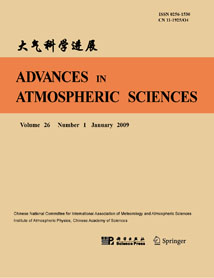| [1] |
Sang Seo PARK, Yun Gon LEE, Jung Hyun KIM,
2015: Impact of UV-A Radiation on Erythemal UV and UV-index Estimation over Korea, ADVANCES IN ATMOSPHERIC SCIENCES, 32, 1639-1646.
doi: 10.1007/s00376-015-4231-7
|
| [2] |
Wang Pucai, Jacqueline Lenoble,
1996: Influence of Clouds on UV Irradiance at Ground Level and Backscattered Exittance, ADVANCES IN ATMOSPHERIC SCIENCES, 13, 217-228.
doi: 10.1007/BF02656864
|
| [3] |
Sang Seo PARK, Yeonjin JUNG, Yun Gon LEE,
2016: Spectral Dependence on the Correction Factor of Erythemal UV for Cloud, Aerosol, Total Ozone, and Surface Properties: A Modeling Study, ADVANCES IN ATMOSPHERIC SCIENCES, 33, 865-874.
doi: 10.1007/s00376-016-5201-4
|
| [4] |
Fei XIE, Yan XIA, Wuhu FENG, Yingli NIU,
2023: Increasing Surface UV Radiation in the Tropics and Northern Mid-Latitudes due to Ozone Depletion after 2010, ADVANCES IN ATMOSPHERIC SCIENCES, 40, 1833-1843.
doi: 10.1007/s00376-023-2354-9
|
| [5] |
HU Bo, WANG Yuesi, LIU Guangren,
2008: Influences of the Clearness Index on UV Solar Radiation for Two Locations in the Tibetan Plateau---Lhasa and Haibei, ADVANCES IN ATMOSPHERIC SCIENCES, 25, 885-896.
doi: 10.1007/s00376-008-0885-8
|
| [6] |
Bian Jianchun, Chen Hongbin, Zhao Yanliang, Lü Daren,
2002: Variation Features of Total Atmospheric Ozone in Beijing and Kunming Based on Dobson and TOMS Data, ADVANCES IN ATMOSPHERIC SCIENCES, 19, 279-286.
doi: 10.1007/s00376-002-0022-z
|
| [7] |
Dongxu YANG, Yi LIU, Zhaonan CAI, Xi CHEN, Lu YAO, Daren LU,
2018: First Global Carbon Dioxide Maps Produced from TanSat Measurements, ADVANCES IN ATMOSPHERIC SCIENCES, 35, 621-623.
doi: 10.1007/s00376-018-7312-6
|
| [8] |
You Ronggao, Hong Zhongxiang, Lu Weixiu, Zhao Deshan, Kong Qinxin, Zhu Wenqin,
1985: VARIATIONS OF ATMOSPHERIC AEROSOL CONCENTRATION AND SIZE DISTRIBUTION WITH TIME AND ALTITUDE IN THE BOUNDARY LAYER, ADVANCES IN ATMOSPHERIC SCIENCES, 2, 243-250.
doi: 10.1007/BF03179756
|
| [9] |
Sandeep D. WAGH, Baban NAGARE, Sanjay D. MORE, P. Pradeep KUMAR,
2017: Multiyear Observations of Deposition-Mode Ice Nucleating Particles at Two High-Altitude Stations in India, ADVANCES IN ATMOSPHERIC SCIENCES, 34, 1437-1446.
doi: 10.1007/s00376-017-7048-8
|
| [10] |
Xuefen ZHANG, Liangxu LI, Rongkang YANG, Ran GUO, Xia SUN, Jianping LUO, Hongbin CHEN, Daxin LIU, Kebing TANG, Wenwu PENG, Xiaodong HAN, Qiyun GUO, Xiaoxia LI, Xikun FEI,
2021: Comprehensive Marine Observing Experiment Based on High-Altitude Large Unmanned Aerial Vehicle (South China Sea Experiment 2020 of the “Petrel Project”), ADVANCES IN ATMOSPHERIC SCIENCES, 38, 531-537.
doi: 10.1007/s00376-020-0314-1
|
| [11] |
Fang Juan, Wu Rongsheng,
2001: Topographic Effect on Geostrophic Adjustment and Frontogenesis, ADVANCES IN ATMOSPHERIC SCIENCES, 18, 524-538.
doi: 10.1007/s00376-001-0042-0
|
| [12] |
CHEN Lianshou, LUO Zhexian,
2004: A Study of the Effect of Topography on the Merging of Vortices, ADVANCES IN ATMOSPHERIC SCIENCES, 21, 13-22.
doi: 10.1007/BF02915676
|
| [13] |
DUAN Yihong, WU Rongsheng, YU Hui, LIANG Xudong, Johnny C L CHAN,
2004: The Role of -effect and a Uniform Current on Tropical Cyclone Intensity, ADVANCES IN ATMOSPHERIC SCIENCES, 21, 75-86.
doi: 10.1007/BF02915681
|
| [14] |
LING Jian, LI Chongyin, ZHOU Wen, JIA Xiaolong, Chidong ZHANG,
2013: Effect of Boundary Layer Latent Heating on MJO Simulations, ADVANCES IN ATMOSPHERIC SCIENCES, 30, 101-115.
doi: 10.1007/s00376-012-2031-x
|
| [15] |
MIAO Shiguang, LI Pingyang, WANG Xiaoyun,
2009: Building Morphological Characteristics and Their Effect on the Wind in Beijing, ADVANCES IN ATMOSPHERIC SCIENCES, 26, 1115-1124.
doi: 10.1007/s00376-009-7223-7
|
| [16] |
FANG Juan, TANG Jianping, WU Rongsheng,
2009: The Effect of Surface Friction on the Development of Tropical Cyclones, ADVANCES IN ATMOSPHERIC SCIENCES, 26, 1146-1156.
doi: 10.1007/s00376-009-8020-z
|
| [17] |
Zhao Ming,
1991: The Effect of Topography on Quasi-Geostrophic Frontogenesis, ADVANCES IN ATMOSPHERIC SCIENCES, 8, 23-40.
doi: 10.1007/BF02657362
|
| [18] |
Zhang Pei, Ni Yunqi,
1991: Effect of Nonlinear Dynamic Process on Formation and Breakdown of Blocking, ADVANCES IN ATMOSPHERIC SCIENCES, 8, 41-50.
doi: 10.1007/BF02657363
|
| [19] |
BI Yun, CHEN Yuejuan, ZHOU Renjun, YI Mingjian, DENG Shumei,
2011: Simulation of the Effect of an Increase in Methane on Air Temperature, ADVANCES IN ATMOSPHERIC SCIENCES, 28, 129-138.
doi: 10.1007/s00376-010-9197-x
|
| [20] |
Zhang Pei, Ni Yunqi,
1991: The Effect of Topographic Forcing on the Formation and Maintenance of Blocking, ADVANCES IN ATMOSPHERIC SCIENCES, 8, 317-326.
doi: 10.1007/BF02919614
|















 AAS Website
AAS Website 
 AAS WeChat
AAS WeChat 
 DownLoad:
DownLoad: